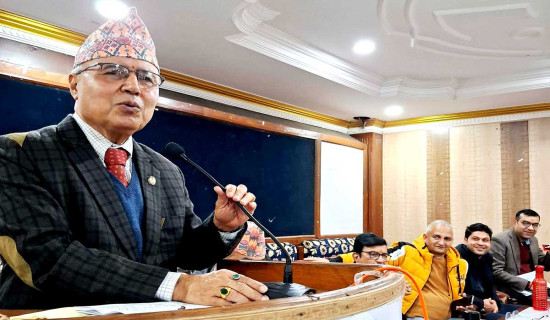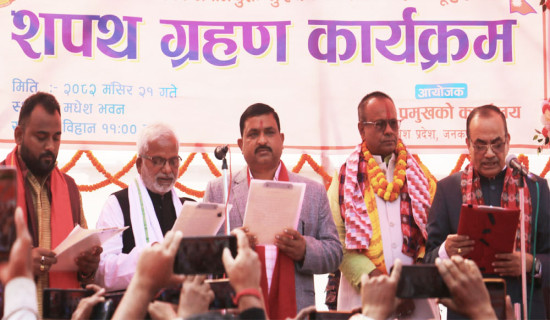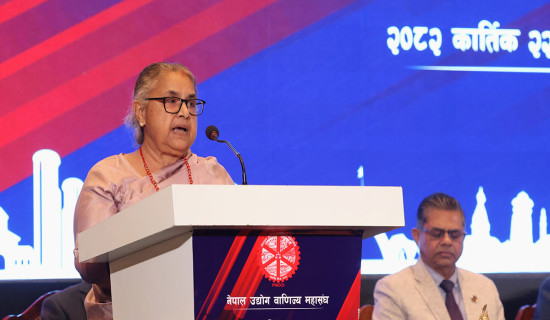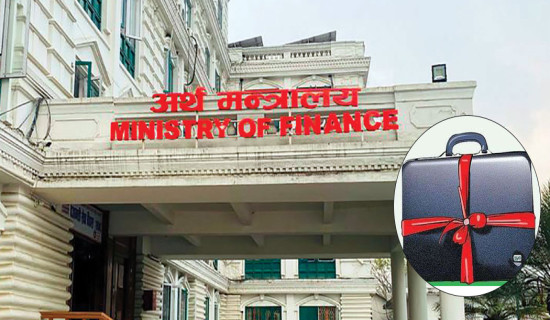- Monday, 8 December 2025
Decades of glory and troubles
What went wrong with Nepal’s cooperatives?
Kathmandu, Nov. 10: Past seven decades of the cooperatives movement in Nepal, including the 30 years during the monarchy-led Panchayat regime, created a glorious legacy of financial inclusion, community empowerment and savings culture among the grassroots people.
The cooperatives is one of the two successful public movements that Nepal could boast at the international level along with the Community Forest Users Groups. Both the initiatives were launched during the Panchayat era (community forest in late 1980s) but prospered in the liberal economic and social environment guaranteed by the democratic regimes after 1990.
But the financial mismanagement, mobilisation of funds to unauthorised sectors and fulfillment of personal greed with the public’s deposit by some medium- and large-sized cooperative organisations of late have obscured the achievements made in the sector touted as the third pillar of the national economy.
According to the Nepal Police, it has registered 212 cases of fraud in cooperatives at the court, claiming more than Rs. 80 billion in fines in the last three fiscal years. The police have arrested 411 while 1,397 are at large. Personalities ranging from lawmakers, local body representatives, media entrepreneurs and ministers have been arrested and put behind bars in the cases related to cooperatives.
Of more than 34,000 cooperatives in operation (as estimated by the Department of Cooperatives - DoC) about 100 are considered as ‘problematic’ but these are the large saving and credit cooperatives (SACOS) affecting hundreds of thousands of depositors. This ensued fear among the general masses and an unprecedented cooperatives-run was witnessed in various parts of the country.
According to the experts, many people who deposited the money earned through illegal means such as bribery, black marketing, smuggling and illegal trade in cooperatives have not come out opening or registered any cases fearing the punishment under anti-money laundering laws or criminal acts.
Factors behind the crisis
What caused the debacle in the cooperatives that involves about 6.5 million members and has about 3 per cent contribution to the national economy by 2020?
“This is the result of indifference of and non-adherence to the principles of cooperatives,” said Rishi Raj Ghimire, cooperatives expert and former President of Nepal Federation of Savings and Credit Cooperative Unions Ltd. (NEFSCUN) who also served as an expert member in the commission to investigate the troubled SACOS led by Gauri Bahadur Karki, former Chairperson of the Special Court, in 2013. “Corruption in self-discretion, loss in integrity, lack of regulation and greedy regulatory authorities helped in aggravating the problem,” he said.
However, the recent crisis has not emerged out of the blue. By May 2014, the Karki-led commission had received 22,170 compliants from 12,962 individuals against 162 cooperatives claiming Rs. 10.08 billion. They even complained that they were deprived of the interest on the deposits as well.
The problems in the SACOS then were the result of non-adherence to the values of cooperative, absence of timely and appropriate policy and regulatory body, and lack of monitoring, the commission had concluded.
But the government, Ministry of Land Management, Cooperatives and Poverty Alleviation (MoLMCPA), and the DoC paid no heed to the recommendations to the commission. Interestingly, this was neither the first nor the last dullness in their part. There were at least four probe committees/commissions before it and at least two after that, all of them recommended various measures to address the challenges in the sector and lead it to the path of ‘healthy business’.
There were problems in cooperatives when they were run as ‘Sajha Programme’ during the Panchayat era. Although there were few of them, their ‘sickness’ is still visible in Sajha Publication, Sajha Health Service and Sajha Yatayat.
According to Ghimire, the problems then were also the result of poor regulation and monitoring and corruption by the officials.
The Parliamentary Investigation Special Committee on Misuse of Co-operatives Saving formed in 2024 concluded that about Rs. 87.88 billion has been embezzled by 40 cooperatives of which 22 are categorised as ‘sick’ and 18 have ‘questionable practices’.
According to the House Committee, there is no problem in the SACOS that are operated as per the norms, values and principles of cooperative, and prevailing legal instruments. The problem is rampant in the SACOS that are managed by the people who run the organisations as ‘mini bank’ in the disguise of social activists and general consumers.
The root of the problem is the tendency to influence the state power to make the laws in their favour with the deposits from general customers lured with attractive interest and not letting even to recognise the problem whenever there is any, concluded the House Committee led by lawmaker Surya Thapa. The committee also blamed the government for protecting the corrupt people in the cooperatives.
“It is the responsibility of the state to protect the interests of the victims who are forced to die without treatment due to the fact that they did not get back the savings from the cooperatives they earned after selling their labour and sweat,” read the report. It further said that there is a kind of ‘anarchism’ as many of the operators of SACOS don’t follow values, policy and system.
Poor regulation
According to the experts of the cooperatives sector, weak regulation and monitoring by the governmental bodies, lack of professional conduct and management within the cooperatives, and poor transparency and accountability significantly complicated the problems.
“At times, there were collusions between the ill-intended managers of the cooperatives and officials of the regulatory bodies. They overlooked the multiple compliants and recommendations and let the manager and board of directors siphon off the public’s money,” said Paritosh Paudyal, Director of National Cooperative Federation (NCF) of Nepal.
According to him, within a decade since the country adopted liberal stance on cooperative registration and operation in 1990, about 100 cooperatives had shut their business and run away.
Most of the professionals from the cooperative sector also agree on the fact that the problems were created and exacerbated with the mobilisation of investment in non-financial sectors including real estate, housing, television and many others. Paudyal said that the cooperative should invest in natural person not on legal entities like companies.
But large cooperatives like Gautam Shree, Surya Darshan and Oriental mobilised the depositors’ money to real estate and media companies.
Large number of co-ops
Nepal probably has the largest number of cooperatives by any means in the world. According to 2019 statistics, Nepal had 34,000 cooperatives against 5684 in the United States of America, 2705 in India, 888 in Bangladesh, 79 in Australia and 567 in Canada. Cooperatives in Nepal are categorised into various sectors including saving and credit, multipurpose, agriculture, fruits and vegetables, beekeeping, tea and coffee, and consumers.
Such a large number of cooperatives are regulated by the DoC with a very limited human resources and information technology infrastructure.
Furthermore, after the country was ushered into the federal system, regulation and monitoring of cooperatives has been divided into the three levels of the government but none of them has been able to monitor them. The DoC says that it has the responsibility of only 147 large cooperatives but it has long been failing to regulate even them. Meanwhile, the provincial and local governments have neither proper infrastructure, human resources and skill to regulate and monitor the sector.
According to the DoC, it would be able to perform the regulation task if there were credit information bureau, credit tribunal and periodic reporting mechanism for the cooperatives.
Responding to the situation, the then Minister for Cooperatives, Padma Kumari Aryal in 2019 had suggested bringing down the number of cooperatives to 12,000 maximum, and urged for voluntary mergers of the organisations with similar objectives, coverage area and member base.
“But the government allowed the merger of a cooperatives in different districts which helped them to collect the money from small towns and villages and invest in real estate,” said Rishi Raj Ghimire.
Likewise, Paritosh Paudyal said that the Bagmati Provincial government has the responsibility of 2,400 cooperatives while it has only 24 staff at the ministry responsible for the regulation of the sector and most of them are not trained for the job.
Meanwhile, most of the cooperatives have semi-skilled human resources to run the business who are mostly submissive to their chief of Board of Directors. In the past 62 years, the Cooperative Training and Research Centre has trained 20,000 staff of cooperative. NEFSCUN also runs various trainings for the staff of various level but given the significant HR turnover and large number of employees, they are not sufficient, experts say.
Immediate solutions
Various committees and probe commissions formed to study the problems in the cooperative sector and experts pointed out the need of a strong regulation mechanism to purge the sector from the current maladies. Many of them advocated the ‘Second-Tier Institution (STI)’ to regulate the sector but some campaigners said that it would be another level of complexities added to the system.
However, the STI has been mentioned in several government policies including annual budgets and monetary policies of the Nepal Rastra Bank (NRB) in the past two decades. Then Finance Minister late Bharat Mohan Adhikari had announced to create a regulatory body for the cooperatives in 2005.
The dillydallying of the government is seen in cooperative policy as well as it came after two decades since the country adopted liberal stance to the cooperatives.
“What is the need of the hour is a strong and autonomous regulatory mechanism including the representatives from the NRB, chartered accountant, Ministry of Finance, Ministry of Cooperative and DoC,” said Ghimire.
The cooperatives and experts have long been demanding credit information bureau, strong IT infrastructure which would facilitate virtual monitoring of business, promotion of mergers, deposit guarantee fund and stabilization fund.
“Basically, the sector needs a new law with clear definition of membership, work scope, forced merger, qualification of directors and separate intelligence unit inside the regulator,” according to Ghimire.
Other suggestions include making the non-adherence to the cooperative principles a criminal offence, running cooperatives as per two-tier system keeping federal and local regulation and removing provincial structure from it, and allowing the central federation of cooperatives to conduct the initial monitoring.
The Cooperative Sector Reform Suggestion Task Force led by Dr. Jaykant Raut, member of the National Planning Commission, last year recommended conducting a detailed study of SACOS within six months but it went in vain.
It also suggested conducting capacity building training for all elected officials of cooperatives.
The cooperative policy also proposes for systematic and external auditing, resolve of the conflict of interest, formulation of standards, and effective monitoring from the associations. The Karki Commission has also suggested for a powerful rehabilitation commission to settle the problems of the sick cooperatives.















